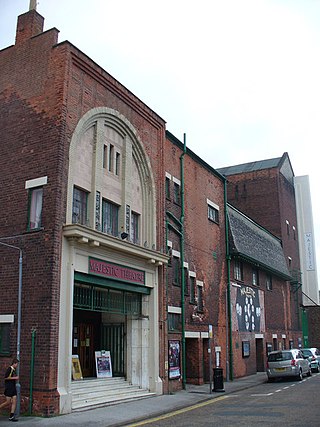
Beeston is a town in the Borough of Broxtowe, Nottinghamshire, England, it is 3 miles south-west of Nottingham. To its north-east is the University of Nottingham's main campus, University Park. The headquarters of pharmaceutical and retail chemist group Boots are 0.6 miles (1 km) east of the centre of Beeston, on the border with Broxtowe and the City of Nottingham. To the south lie the River Trent and the village of Attenborough, with extensive wetlands.

Attenborough is a village in the Borough of Broxtowe in Nottinghamshire, England. It forms part of the Greater Nottingham area and is 4+1⁄2 miles (7.2 km) to the south-west of the city of Nottingham, between Long Eaton and Beeston. It adjoins the suburbs of Toton to the west and Chilwell to the north. The population of the ward, as at the 2011 Census, was 2,328.

Beeston and Stapleford was an urban district in Nottinghamshire, England, from 1935 to 1974.

St. Giles' Church, West Bridgford is an Anglican parish church in West Bridgford, Nottinghamshire.
William Herbert Higginbottom JP was an architect based in Nottingham.

William Arthur Heazell FRIBA was an architect based in Nottingham.

William Beedham Starr JP was an architect based in Nottingham.

Alfred John Thraves FRIBA was an architect based in Nottingham who specialised in cinema design.

Evans, Clark and Wollatt was an architectural practice based in Nottingham from the early 1920s to 1948.

John Rigby Poyser LRIBA was an English architect based in Nottingham.

Charles Nelson Holloway was an architect based in Nottingham.

George Francis Grimwood LRIBA was an 20th century engineer and architect based in Nottingham.

John Bowley LRIBA was an architect and engineer based in England who worked mainly in Beeston, Nottinghamshire and Hastings.

Alexander Wilson LRIBA was an architect based in Nottingham. Some of his most significant work include the 900 houses built on the Beeston Rylands estate in the late 1930s.

Thomas Woolston was an architect and builder.

Henry Hardwick Dawson FRIBA was an architect based in Nottingham.

Captain Albert Edgar Eberlin FRIBA MC was an architect based in Nottingham.
Douglas Leonard Booth was an architect, surveyor and civil engineer based in Beeston, Nottinghamshire.

Wollaton Road, Beeston runs north from its junction with High Road, Beeston to Derby Road.

Lieut-Colonel Herbert Walker FRIBA, M Inst CE, FSI, was an architect, surveyor and civil engineer based in Nottingham from 1870 to 1923.





















